If you’ve been waking up feeling stiff and achy, or if you have noticed that your posture is not as good as it should be, it’s time to start stretching.
A good stretching program has more benefits than just being able to impress your friends by touching your toes. You’ll be surprised at how much better your body moves and feels when your overall mobility improves.
“An effective stretching program is your ‘joint maintenance’ and is the way to prevent pain and injury,” says Grayson Wickham, DPT, CSCS, physical therapist, certified strength and conditioning specialist, and founder of Movement Vault. “It also ensures that your body and joints are moving like they should.”
If you’re not sure where to start in your journey to better flexibility, we’ve got you covered. Ahead, we dive into how to become more flexible with expert tips, exercises, and a program you can follow.
What is flexibility and why is it important?
When you think of stretching, you may think of holding a position for a period of time—like holding a hamstring stretch, for example. While that’s part of it, there are many ways you can improve your flexibility and mobility. The trick is knowing how to stretch, when to stretch, and how to incorporate more moves that encourage mobility throughout your day.
“People spend way too much time sitting and not moving, and are not getting in enough varied movement in their daily routine,” Wickham says. “An effective active stretching program is the antidote for the tight muscles, poor muscle activation, and poor mobility that is the consequence of all of this lack of movement and sitting.”
In fact, a 2017 study in BMC Health Services Research saw a correlation between better mobility as you age and a longer lifespan. While correlation doesn’t equal causation, it’s definitely an incentive to start stretching!
Flexibility vs. mobility: What’s the difference?
Many people use the terms flexibility and mobility interchangeably–but they actually have very different meanings.
“Flexibility is a precursor to mobility. In order to have good mobility, you must first have good flexibility,” Wickham says. “Having good flexibility by itself is not very useful unless you’re trying to show off on social media by doing the splits or other passive, non-moving positions.”
Flexibility, on the other hand, is the amount you can passively elongate or stretch out a connective tissue without contracting muscles and without actively moving a joint, according to Wickham.
“You can think about mobility as the amount of range of motion that you actively move your joint through,” he explains.
For example, being able to do the splits means you’re flexible. If you can actively kick your leg up high (think of the Rockettes doing their eye-high leg kicks), then you have good mobility.
“Mobility is what you should focus on. Active joint mobility is what translates to active movement in your day-to-day activities, in the gym, and in your sport,” he says. It also helps you do daily activities—like bending down, reaching overhead, or getting out of bed—easier.
Ideally, you should have both good flexibility and full range of motion in your joints, along with good mobility to help you move with ease. A stretching routine will help you get both.
The benefits of stretching that’ll motivate you to start a routine
A regular stretching routine has many benefits on both your physical and mental wellbeing. Here are five reasons to start stretching.
1. It prevents injuries
“Injury prevention is probably the number one reason for flexibility,” says Denise Chakoian, CPT, founder of CORE Studios in Providence, Rhode Island. “It helps to keep the muscles more limber, and you also recover quicker from workouts.”
Stretching helps prevent muscle imbalances and allows the joint to move through its full range of motion. This ensures that your body is moving like it should and is less prone to injuries.
2. It improves athletic performance
A 2017 review in Sports Medicine found that doing dynamic stretching before exercise or athletic performance increases muscle power, force, sprint speed, and jump height. It improves muscle strength as your muscles and joints are moving and working like they should.
Wickham says stretching also improves body awareness and balance, which also translates into improved performance with sports and daily activities.
3. It enhances range of motion
Stretching helps maintain and improve the range of motion in your joints, according to a 2012 research article in the International Journal of Sports Physical Therapy.
All types of stretching are beneficial, per the article, including static and dynamic, but proprioceptive neuromuscular facilitation (PNF) stretching produces the most immediate gains. (More on PNF stretching below!)
4. It boosts cardiovascular health
You may be surprised to learn that stretching is good for your heart. A 2020 study in the Journal of Physiology found that a 12-week stretching routine lowered blood pressure, improved blood flow, and decreased arterial stiffness. This translates into a decreased risk of strokes and heart attacks.
5. It promotes relaxation
Feeling stressed? A regular stretching routine helps to loosen up tight muscles, increases circulation, and leaves you feeling relaxed and less tense.
“An effective stretching program is your ‘joint maintenance’ and is the way to prevent pain and injury. It also ensures that your body and joints are moving like they should.” —Grayson Wickham, DPT, CSCS
Tips on how to become more flexible and mobile
To improve your mobility and flexibility, it’s important to know when and how to stretch. There are different types of stretching techniques.
1. Static stretching
This what most people think of when they think about stretching. This is when you do a stretch and hold it in place for 30 to 60 seconds.
Experts say this type of stretching improves flexibility and range of motion, but should be done after exercise when your muscles are warmed up.
Doing static stretches before an activity may decrease strength and performance, according to a 2019 review in Frontiers in Physiology. However, this side effect is probably felt only in elite or competitive athletes.
2. Dynamic stretching
This is when you actively move your body through a stretch. This type of stretching should be done as a warm-up before an activity, and it helps improve range of motion and mobility. Examples of dynamic stretches include leg swings, arms circles, and lunges.
3. PNF stretching
This is a more active type of stretching that improves mobility, strength, and joint stability. It also happens to be Wickham’s preferred method of stretching.
“Active stretching happens when you maximally stretch out a muscle and then contract that same muscle while it’s maximally stretched out. You will hold this muscle contraction for a specific amount of time,” Wickham says. “You should focus on active stretching, which will significantly improve your flexibility and active mobility at the same time. This is one reason why active stretching is a great use of time and the best bang for your buck.”
Here are more tips on stretching effectively:
- For best results, do dynamic stretches as a warm-up before the activity, followed by active, PNF, or static stretches after the activity.
- Not a fan of stretching before or after exercise? Try a 15-minute flexibility flow. “I like to do a flow for flexibility,” Chakoian says. “I find that stretching cold is not a great idea, but to move our bodies in a flow with one move after another helps improve mobility.” Yoga is also a great exercise to combine mobility and strengthening.
- Look for moments throughout the day to stretch and move more. If you sit at a desk all day, stand up at least once an hour and do some arm circles, hip flexor stretches, and chest opening stretches to prevent a hunched position. If you stand all day, do some gentle trunk rotations on the floor. “Start by doing small movements on the floor, with some deep breathing exercises,” Chakoian says.
- Utilize tools to help you stretch effectively, like a foam roller or yoga block. “Using a tool like a long resistance band is very helpful to improve your flexibility daily,” Chaloian says. The band can be placed over your foot when doing a hamstring stretch or between your hands to help you stretch out your shoulders.
The best moves to improve mobility
Wickham shares his seven favorite active or PNF stretches to try at home. These may feel different than the flexibility stretches you’re used to, but you’ll be surprised at how much mobility you can gain.
1. Hamstring stretch

- Begin by kneeling on both knees.
- Place the heel of your left leg in front of you and place both hands to the right side of your left leg.
- Push your left leg out as straight as you can. You should feel a stretch, but not pain.
- Push your left heel down into floor to contract your hamstring. Your leg should not move.
- Contract and hold for 10 to 20 seconds.
- Relax and then try to push your leg out further, going deeper into the stretch.
- Repeat this 3 to 4 times, each time trying to move your leg out a little further.
- Repeat on the other side.
2. Inner thigh stretch
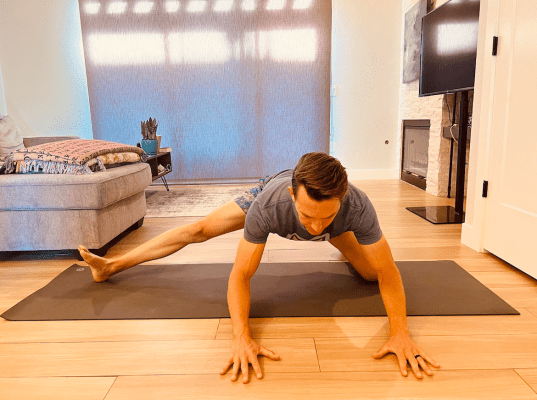
- Begin by kneeling on both knees.
- Place the heel of your left leg out to the side and place both hands out in front of you.
- Push your left leg out to the side as far as you can. You should feel a stretch, but not pain.
- Push your left heel down into floor to contract your inner thigh muscle. Your leg should not move.
- Contract and hold for 10 to 20 seconds.
- Relax and then try to push your leg out further, going deeper into the stretch.
- Repeat this 3 to 4 times, each time trying to move your leg out a little further.
- Repeat on the other side.
3. Calf stretch
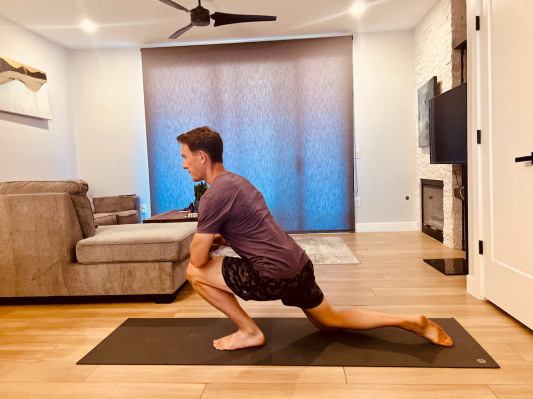
- Begin by kneeling on both knees.
- Bring your left leg in front of you and bend it. Extend your right leg behind you.
- Rest your arms on your bent leg and shift your body weight forward slightly.
- Maximally stretch out your calf muscles by moving your left knee forward over the middle of your left foot.
- Press the ball of your left foot down into the ground as you feel your calf muscles tighten
- Hold contraction for 10 to 20 seconds.
- Relax between reps, trying to get deeper in the stretch each time.
- Repeat this 3 to 4 times.
- Repeat on the other side.
4. Shoulder stretch

- Lie on the floor on your stomach.
- Maximally stretch out your lats, rotator cuff, and triceps muscles on your left side by keeping your left arm close to your ear while it’s bent.
- Drive your arm down into the ground, contracting your shoulder muscles.
- Hold contraction for 10 to 20 seconds.
- Relax and try to get deeper in the stretch.
- Repeat this 3 to 4 times.
- Repeat on the other side.
5. Pectoralis chest stretch
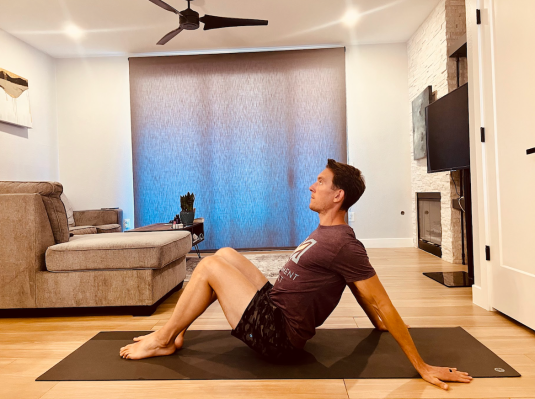
- Sit on the floor with your knees bent in front of you, feet flat on the floor.
- Place your arms behind your, slightly wider than shoulder-width apart, with your fingertips pointed away from you. Place your palms on the ground.
- Maximally stretch out your pectoralis muscles by opening up your chest as much as possible.
- Drive your arms down into the ground, contracting your chest muscles.
- Hold contraction for 10 to 20 seconds.
- Relax and try to get deeper in the stretch.
- Repeat this 3 to 4 times.
- Repeat on the other side.
6. Active pigeon pose stretch
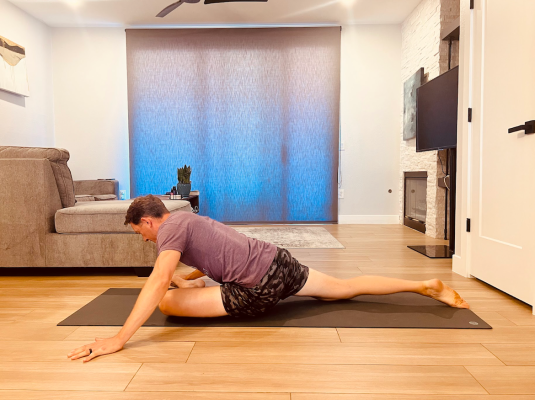
- Begin by kneeling on both knees.
- Place your right leg straight behind you and bend your left leg in front of you.
- Lower your left hip, shin and ankle to the ground.
- Place your arms in front of you for support.
- Maximally stretch out your glute and hip muscles by hinging at your hip and holding over your front leg as much as possible.
- Make sure this movement is coming from your hip and not your back.
- Drive your front leg down into the ground contracting these same hip muscles that are maximally stretched out.
- Hold contraction for 10 to 20 seconds.
- Relax and try to get deeper in the stretch.
- Repeat this 3 to 4 times.
- Repeat on the other side.
7. Hip flexor stretch
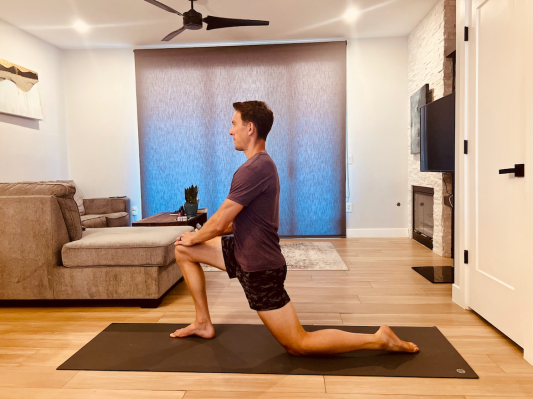
- Start in a half-kneeling position with your right knee bent in front of you and your left knee slightly extended behind you.
- Maximally stretch out your hip flexor muscles by shifting your body forward.
- Make sure this movement is coming from your hip and not your low back.
- Drive your back leg down into the ground contracting your quadriceps (front of thigh) muscles that are maximally stretched out.
- Hold contraction for 10 to 20 seconds.
- Relax and try to get deeper in the stretch.
- Repeat this 3 to 4 times.
- Repeat on the other side.
Sample flexibility training program
“Everyone, regardless of age, background, or fitness level, should be performing an effective active stretching program for 10 minutes, three times per week,” Wickham says.
In addition, getting some sort of mobility work each day will help you gain all the wonderful benefits of stretching.
Not sure where to start? Here is a sample flexibility program to give you an idea.
Monday
- 10 minutes of dynamic stretches to warm up
- 30 minutes of walking/running/cycling or other cardio
- 10 minutes of active, PNF, or static stretching
Tuesday
- 15- to 30-minute yoga flow in the morning
Wednesday
- 10 minutes of dynamic stretches to warm up
- 30 minutes of hiking
- 10 minutes of active, PNF, or static stretching
Thursda
- 45-minute yoga class
- 15 minutes of stretches using an exercise ball
Friday
- 10 minutes of dynamic stretches to warm up
- 30 minutes of walking/running/cycling or other cardio
- 10 minutes of active, PNF, or static stretching
Saturday
- 15- to 30-minute yoga or flexibility flow
Sunday
Common mistakes
To get the maximum benefits of stretching and prevent injuries, avoid these three common stretching mistakes.
1. Not warming up
Unless you’re doing dynamic stretches (which can be used as a warm-up), you should prime your muscles for stretching by doing a 10- to 15-minute warm-up, such as walking, cycling, or activities like jumping jacks.
You can also just plan on doing a stretching routine after exercising. This gets your blood flowing and your muscles loose and ready for movement. “Going too far, too fast, and when the body is cold is not going to be helpful,” Chaloian says.
2. Not listening to your body
Another major mistake is not listening to your body and modifying the stretch, Wickham says. “If you’re performing an active stretch and you have sharp joint pain, numbness, and tingling, or a burning sensation, you need to either change up your range of motion or swap out that stretch for a different stretch,” he says.
When you stretch, you will feel a pulling sensation and possibly some mild discomfort, but you should never feel any sharp pains. If you’ve tried many different stretches and still feel pain, chat with your doctor or physical therapist to figure out what’s going on.
3. Improper form
To gain the maximum benefits and to prevent injury, make sure you’re doing the stretch correctly. Watching yourself in a mirror or working with a trainer can be helpful.
FAQ
1. Why is my flexibility so poor?
“Your body adapts to the positions that you spend the most time in,” Wickham says. “Most people spend way too much time not moving and sitting. Not only that, but they’re sitting in a hunched-over position, slumped at their computer desk. Your body will adapt over the years and this is one of the biggest contributors to having poor flexibility and mobility.”
2. How long does it take to increase flexibility?
“This depends on many factors including your age, your current flexibility and mobility level, and your day-to-day activity routines—like how much varied movement you’re getting in on a typical day,” Wickham says.
When performing effective active stretching, you can make improvements in as little as one stretching session no matter how old you are, according to Wickham.
“With that in mind, if you’re older and you have significantly tight muscles, it’ll take time to reverse the changes that have happened to your body over the years and decades of sitting and lack of movement. If you stay consistent you can continually see results every month and you will see significant flexibility and mobility results within six months,” Wickham says.
3. Should I stretch every day?
“I think doing mobility and flexibility daily is great, however, most people do not commit to this,” Chaloian says. “I would say doing this type of movement or stretching at least three days per week would show a great improvement.”
Well+Good articles reference scientific, reliable, recent, robust studies to back up the information we share. You can trust us along your wellness journey.
-
Bergland, A., Jørgensen, L., Emaus, N. et al. Mobility as a predictor of all-cause mortality in older men and women: 11.8 year follow-up in the Tromsø study. BMC Health Serv Res 17, 22 (2017). https://doi.org/10.1186/s12913-016-1950-0 -
Opplert, J., Babault, N. Acute Effects of Dynamic Stretching on Muscle Flexibility and Performance: An Analysis of the Current Literature. Sports Med 48, 299–325 (2018). https://doi.org/10.1007/s40279-017-0797-9 -
Page P. Current concepts in muscle stretching for exercise and rehabilitation. Int J Sports Phys Ther. 2012 Feb;7(1):109-19. PMID: 22319684; PMCID: PMC3273886. -
Bisconti, A.V., Cè, E., Longo, S., Venturelli, M., Coratella, G., Limonta, E., Doria, C., Rampichini, S. and Esposito, F. (2020), Evidence for improved systemic and local vascular function after long-term passive static stretching training of the musculoskeletal system. J Physiol, 598: 3645-3666. https://doi.org/10.1113/JP279866 -
Chaabene H, Behm DG, Negra Y, Granacher U. Acute Effects of Static Stretching on Muscle Strength and Power: An Attempt to Clarify Previous Caveats. Front Physiol. 2019 Nov 29;10:1468. doi: 10.3389/fphys.2019.01468. PMID: 31849713; PMCID: PMC6895680.











